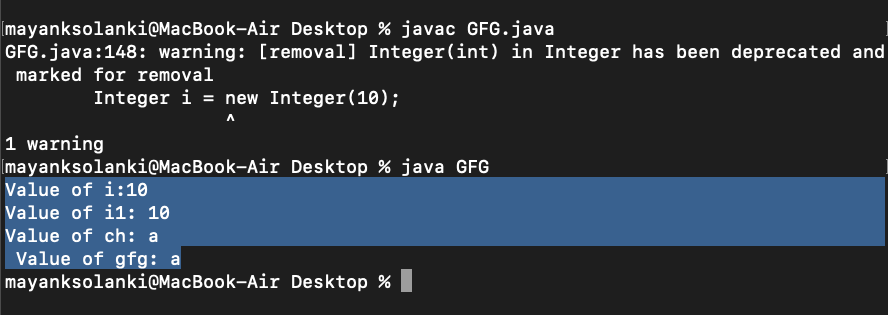Java中的自动装箱和拆箱
在Java中,原始数据类型的处理方式不同,因此引入了包装类,其中两个组件发挥作用,即自动装箱和拆箱。自动装箱是指将原始值转换为相应包装类的对象,称为自动装箱。例如,将 int 转换为 Integer 类。 Java编译器在原始值是以下情况时应用自动装箱:
- 作为参数传递给需要相应包装类的对象的方法。
- 分配给相应包装类的变量。
另一方面,拆箱是指将包装类型的对象转换为其相应的原始值。例如将 Integer 转换为 int。 Java编译器适用于拆箱时包装类的对象是:
- 作为参数传递给需要相应原始类型的值的方法。
- 分配给相应原始类型的变量。
| Primitive Type | Wrapper Class |
|---|---|
| boolean | Boolean |
| byte | Byte |
| char | Character |
| float | Float |
| int | Integer |
| long | Long |
| short | Short |
| double | Double |
下表列出了Java编译器用于自动装箱和拆箱的基本类型及其对应的包装类。现在让我们讨论自动装箱和拆箱的一些优点,以了解我们使用它的原因。
- 自动装箱和拆箱使开发人员可以编写更简洁的代码,使其更易于阅读。
- 该技术让我们可以互换使用原始类型和 Wrapper 类对象,并且我们不需要显式地执行任何类型转换。
示例 1:
Java
// Java program to illustrate the Concept
// of Autoboxing and Unboxing
// Importing required classes
import java.io.*;
// Main class
class GFG {
// Main driver method
public static void main(String[] args)
{
// Creating an Integer Object
// with custom value say it be 10
Integer i = new Integer(10);
// Unboxing the Object
int i1 = i;
// Print statements
System.out.println("Value of i:" + i);
System.out.println("Value of i1: " + i1);
// Autoboxing of character
Character gfg = 'a';
// Auto-unboxing of Character
char ch = gfg;
// Print statements
System.out.println("Value of ch: " + ch);
System.out.println(" Value of gfg: " + gfg);
}
}Java
// Java Program to Illustrate Autoboxing
// Importing required classes
import java.io.*;
import java.util.*;
// Main class
class GFG {
// Main driver method
public static void main(String[] args)
{
// Creating an empty Arraylist of integer type
ArrayList al = new ArrayList();
// Adding the int primitives type values
// using add() method
// Autoboxing
al.add(1);
al.add(2);
al.add(24);
// Printing the ArrayList elements
System.out.println("ArrayList: " + al);
}
} Java
// Java Program to Illustrate Autoboxing
// Importing required classes
import java.io.*;
import java.util.*;
// Main class
class GFG {
// Main driver method
public static void main(String[] args)
{
// Creating an empty ArrayList of integer type
List list = new ArrayList();
// Adding the int primitives type values by
// converting them into Integer wrapper object
for (int i = 0; i < 10; i++)
System.out.println(
list.add(Integer.valueOf(i)));
}
} Java
// Java Program to Illustrate Find Sum of Odd Numbers
// using Autoboxing and Unboxing
// Importing required classes
import java.io.*;
import java.util.*;
// Main class
class GFG {
// Method 1
// To sum odd numbers
public static int sumOfOddNumber(List list)
{
// Initially setting sum to zero
int sum = 0;
for (Integer i : list) {
// Unboxing of i automatically
if (i % 2 != 0)
sum += i;
// Unboxing of i is done automatically
// using intvalue implicitly
if (i.intValue() % 2 != 0)
sum += i.intValue();
}
// Returning the odd sum
return sum;
}
// Method 2
// Main driver method
public static void main(String[] args)
{
// Creating an empty ArrayList of integer type
List list = new ArrayList();
// Adding the int primitives type values to List
for (int i = 0; i < 10; i++)
list.add(i);
// Getting sum of all odd numbers in List
int sumOdd = sumOfOddNumber(list);
// Printing sum of odd numbers
System.out.println("Sum of odd numbers = "
+ sumOdd);
}
} 输出:

让我们了解编译器如何在Java中使用泛型的集合示例中进行自动装箱和拆箱。
示例 2:
Java
// Java Program to Illustrate Autoboxing
// Importing required classes
import java.io.*;
import java.util.*;
// Main class
class GFG {
// Main driver method
public static void main(String[] args)
{
// Creating an empty Arraylist of integer type
ArrayList al = new ArrayList();
// Adding the int primitives type values
// using add() method
// Autoboxing
al.add(1);
al.add(2);
al.add(24);
// Printing the ArrayList elements
System.out.println("ArrayList: " + al);
}
}
输出
ArrayList: [1, 2, 24]输出说明:
在上面的示例中,我们创建了一个 Integer 类型的元素列表。我们正在添加 int 原始类型值而不是 Integer Object,并且代码已成功编译。它不会生成编译时错误,因为Java编译器会从原始 int i 创建一个整数包装对象并将其添加到列表中。
示例 3:
Java
// Java Program to Illustrate Autoboxing
// Importing required classes
import java.io.*;
import java.util.*;
// Main class
class GFG {
// Main driver method
public static void main(String[] args)
{
// Creating an empty ArrayList of integer type
List list = new ArrayList();
// Adding the int primitives type values by
// converting them into Integer wrapper object
for (int i = 0; i < 10; i++)
System.out.println(
list.add(Integer.valueOf(i)));
}
}
输出
true
true
true
true
true
true
true
true
true
true自动和拆箱的另一个示例是在列表中查找奇数的总和。程序中的一个重点是运算符余数 (%) 和一元加号 (+=)运算符不适用于 Integer 对象。但是,代码仍然可以成功编译,因为通过在运行时调用 intValue() 方法将 Integer Object 拆箱为原始 int 值。
示例 4:
Java
// Java Program to Illustrate Find Sum of Odd Numbers
// using Autoboxing and Unboxing
// Importing required classes
import java.io.*;
import java.util.*;
// Main class
class GFG {
// Method 1
// To sum odd numbers
public static int sumOfOddNumber(List list)
{
// Initially setting sum to zero
int sum = 0;
for (Integer i : list) {
// Unboxing of i automatically
if (i % 2 != 0)
sum += i;
// Unboxing of i is done automatically
// using intvalue implicitly
if (i.intValue() % 2 != 0)
sum += i.intValue();
}
// Returning the odd sum
return sum;
}
// Method 2
// Main driver method
public static void main(String[] args)
{
// Creating an empty ArrayList of integer type
List list = new ArrayList();
// Adding the int primitives type values to List
for (int i = 0; i < 10; i++)
list.add(i);
// Getting sum of all odd numbers in List
int sumOdd = sumOfOddNumber(list);
// Printing sum of odd numbers
System.out.println("Sum of odd numbers = "
+ sumOdd);
}
}
输出
Sum of odd numbers = 50